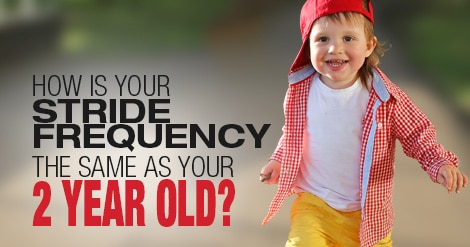Do you remember when your parents celebrated the first time you ran across the room with flawless running form?
Of course not, because it never happened!
Running is such a joyful experience for children, so why would we remove that joy by weighing them down with thoughts and considerations about how to run for maximum efficiency.
To a child, running is a form of play, and adults can learn a lot from children about finding joy in the simplicity of running. Today we are hoping to learn from children in a more practical way.
Last time, we looked at some research on the very basic elements of running biomechanics in an effort to learn how we can maximize efficiency of your running form. Today, we are taking on a similar challenge, but we are going to take it a step further to compare how children and young adults run.
We will be looking into what changes can be found when you compare the biomechanics of a two-year-old running across the room to a 10-year-old running across the playground or an adult running a marathon?
Other than the obvious increase in distance, what can we take away from the science of how our running mechanics change as we grow?

Running mechanics: children vs. adults
The most comprehensive study of running mechanics in children and adults was conducted by three researchers in Italy, and published in 1998. Schepens, Willems, and Cavagna studied 51 children ranging in age from two to 16 years old.
The subjects in the study ran at various speeds across a force plate in a biomechanics lab, and the researchers compared their mechanics to reference values collected from adults aged 25 to 30. Schepens et al. made a number of observations with some interesting implications.
At slow speeds, running can be compared to a simple spring oscillating up and down.
Starting from the “top” of your stride in mid-air, gravity pulls you downward, and as you hit the ground, your muscles and tendons absorb the impact, and proceed to accelerate you back upwards and off the ground.
The up-and-down cycles of this spring-like action mean that it is possible to predict someone’s stride frequency with reasonable accuracy, because it will be equivalent to the natural frequency of the spring model.
A weight hanging by a bungee cord has a natural frequency that you can see and measure by tugging on it—this is just like the natural frequency of your running stride. However, this model is only valid at slow speeds. Schepens et al. noted that the freely chosen stride frequency of children at all ages begins to diverge from the natural frequency of the spring-system model at the same speed: eleven kilometers per hour, or about 8:45 mile pace.
Running at a speed faster than this will cease to follow the simple, symmetric up-and-down of a spring because your vertical acceleration—how hard you push off the ground—exceeds the downward acceleration of gravity.
Of course, to run at any speed, you need to accelerate upwards against the force of gravity, just to get your feet off the ground.
Schepens et al. discovered that, at slow speeds, you push off the ground with an acceleration that mirrors gravity: just like the weight on the bungee cord, your center of gravity spends exactly the same amount of time oscillating downward as it does oscillating up.
However, the picture changes at faster speeds.
To run under 8:45 mile pace, you need to generate more force and do it more rapidly—you’re pushing off the ground much harder, and in less time, so you actually accelerate up while in contact with the ground faster than you fall down at the “top” of your stride (i.e., in midair).
This has some interesting implications for runners whose training or racing paces straddle this 8:45 per-mile threshold.
When you run faster than this pace, your mechanics will change substantially. You will have to push off the ground quicker, and you will spend more time “floating” up in the air. Your muscles will also have to produce more power in a less time, as your time spent on the ground is reduced as you increase your speed.
These findings might also mean that stride frequency is more strictly regulated at slower speeds.
Other research still supports increasing your stride frequency, even at slow speeds, to decrease stress on your body, but Schepens et al.’s results (as well as other work on stride frequency) indicate that this might come at the expense of efficiency.
Research is limited on the effects of stride frequency manipulation at faster speeds, meaning the importance of the 8:45 mile pace “barrier” for faster runners is unclear.
Changes in top speed
Another source of useful information is examining changes in top speed. Though anyone with small children knows they can run deceptively fast, teenagers are still much swifter than two year-olds.
In this study, 16 year olds were able to reach a maximum running speed of 26 kilometers per hour (3:45 per mile), while two year-olds and 10 year-olds were able to reach six (16:20 per mile) and 20 kilometers per hour (4:50 per mile), respectively. As it turns out, this increase in speed comes almost entirely from increases in stride length.
When running at top speed, 16-year-olds and two year-olds have essentially the same stride frequency!
When running at slow to moderate speeds, stride frequency increases in tandem with stride length to produce faster paces, but perhaps the term “turnover” is a misnomer. To significantly increase your speed, a high stride frequency does not appear to be a limiting factor; stride length is.
To increase stride length, you will want to increase your leg muscle strength, especially the hip extensor muscles like the gluteus maximus.
Conclusion
The results of Schepens, Willems, and Cavagna’s research demonstrates two important points.
- There is a marked change in running mechanics that occurs around 8:45 mile pace. Speeds slower than this involve a smooth and symmetric stride, where the “up” portion lasts just as long as the “down” portion. Running faster than this demands an asymmetric stride, with a more rapid and explosive foot contact, and a greater relative proportion of the stride spent in the air. Because this is gravity-dependent, this speed is the same no matter how tall you are or how much you weigh! This might also explain why so many runners get hung up at the four-hour barrier in marathon running—that speed is just a bit slower than this running-mechanics threshold.
- This research shows that having a high enough stride frequency is not typically a limiting factor when it comes to how fast you can run. Even a two-year-old can turn over his or her legs just as fast as you! The difference is in stride length. To run faster, you should work on developing powerful leg muscles, particularly in the hip extensors.
Strength exercises like lunges and squats are great for this, as are plyometric exercises like bounding and skipping, and fast uphill running (make sure you read our guide on how to run hills correctly).
Picking through dense biomechanics papers like this is not always easy, but as you just read, it can lead to some surprising and useful discoveries!
When was the first time you realized you need to pay attention to your running form? How do you make sure you continue to find joy in running?




